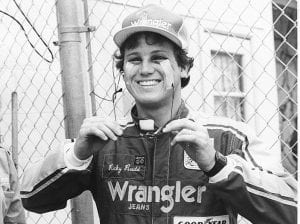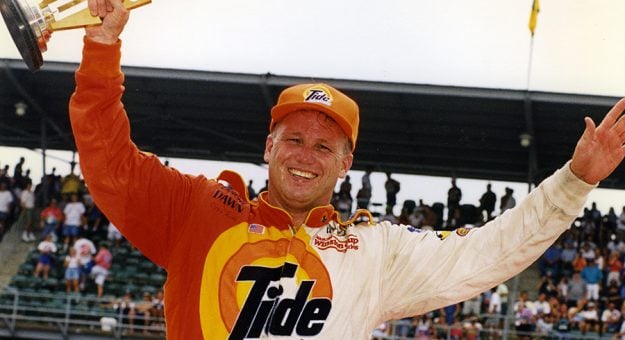During the 1984 Busch Clash at Daytona Int’l Speedway, Rudd crashed into the inside wall in turn four, launching his car into a horrific series of flips.
With his eyes taped open, Rudd finished seventh in the Daytona 500 and won the following weekend at Richmond (Va.) Raceway. Rudd won five more times with Moore through the end of the 1987 campaign.
For the 1988 and ’89 seasons, Rudd joined Kenny Bernstein’s operation with crew chief Larry McReynolds.
“Kenny Bernstein was a great car owner and great for implementing technology into the program,” Rudd said. “One of the major reasons for the success of that team was that he had an Indy car engineer named Bob Riley. Bernstein promised Riley he would enter the Indy 500 if he would come and work for him. The only reason I left was that the Hendrick Motorsports opportunity came available. Bernstein was headed in that direction but didn’t have the top dollars to make that happen like Hendrick did. He was making it work anyway he could but couldn’t get it funded the way it needed to be.”
Rudd moved to Hendrick Motorsports for the 1990 season and rode the team’s vast resources to one victory per season through 1993, finishing second in the championship in 1991.
“Driving for Rick Hendrick was a pretty exciting deal for me,” Rudd said. “We nearly won the championship in 1991 and we led the points right up to the Charlotte race in the fall. If we weren’t leading it, we were five or 10 points apart from Earnhardt. Personally, I feel I made a mistake by leaving (in 1993), but I felt then that being with a multi-car team didn’t seem like the place to be.”
Instead, Rudd took on a new challenge as owner and driver of Rudd Performance Motorsports.

“I learned a lot working with Bud Moore, Kenny Bernstein and Rick Hendrick,” Rudd said. “I learned a little bit about driving the car but also the management structure and how to do things. At the time, I was in my 30s when the opportunity presented itself. The main thought I had was what would I do when my driving career came to an end? At the time, I thought I wanted to have a team as an owner. I started RPM, which was probably the craziest thing I ever did.”
RPM logged six victories, 31 top-five finishes, 68 top-10 efforts and four poles. The biggest victory came in the 1997 Brickyard 400 at Indianapolis Motor Speedway.
“I still remember taking the victory lap around the track in that convertible with Linda sitting beside me and seeing all those fans still in the grandstands after the race,” Rudd recalled. “I also remember after all the press conferences, we were to leave for Michigan that next day to test. Our victory dinner was at Steak n’ Shake right outside the speedway.”
Eventually, Rudd’s sponsorship wasn’t enough to compete and he closed his team after the 1999 season.
“I knew the handwriting was on the wall and knew how much money it was taking to run that race team,” Rudd said. “I could have stayed with what I had, kept the sponsorship dollars with Proctor & Gamble (with the Tide sponsorship), but it was 50 percent of what we really needed at that time to be able to win races again.
“I didn’t want to stay at it and hope to finish in the top 10. I knew the numbers and I knew what we could do and what we couldn’t do,” he continued. “I’m not saying it wasn’t a sad day because it was. I really didn’t have a choice. We probably should have done it a year earlier than we did, to be honest.”
While testing at Indianapolis in 1999, Rudd walked past team owner Robert Yates and said half-jokingly, “I’ll be by the shop on Monday to get fitted for my seat.” Yates didn’t put the connection together at first, thinking it wasn’t a real possibility.
“Ricky joked with me a little bit at Indianapolis and I didn’t give it a second thought,” Yates said in his book, “Robert Yates Racing.” “I figured he’s been successful doing that deal and it’s not an option. So I really didn’t go after it.”
By September, Rudd had a deal to drive the famed No. 28 Ford and he won three races during three seasons driving for the team.
“Robert was very involved in the 28 team,” Ricky said. “He always had some great ideas. The one thing you can’t argue is that Robert always had the horsepower in his engines. He would always say, ‘We’ve got some nice motors to go to Daytona. We should be good. But not like the old days. We used to go to Daytona, and we’d have people beat by 100 horsepower. It was unbelievable we had the competition beat that badly.’ It was kind of neat to hear him talk.”
Rudd then drove four seasons with Wood Brothers Racing before a final one-year stint with the Yates operation.
Rudd has the distinction of having the longest consecutive steak of Cup Series starts at 788, a racing milestone that may never be broken. Rudd earned 23 Cup Series victories, 194 top-five finishes, 374 top-10 results and 29 poles.
